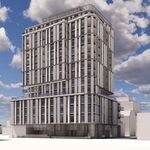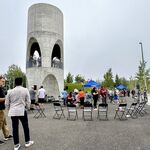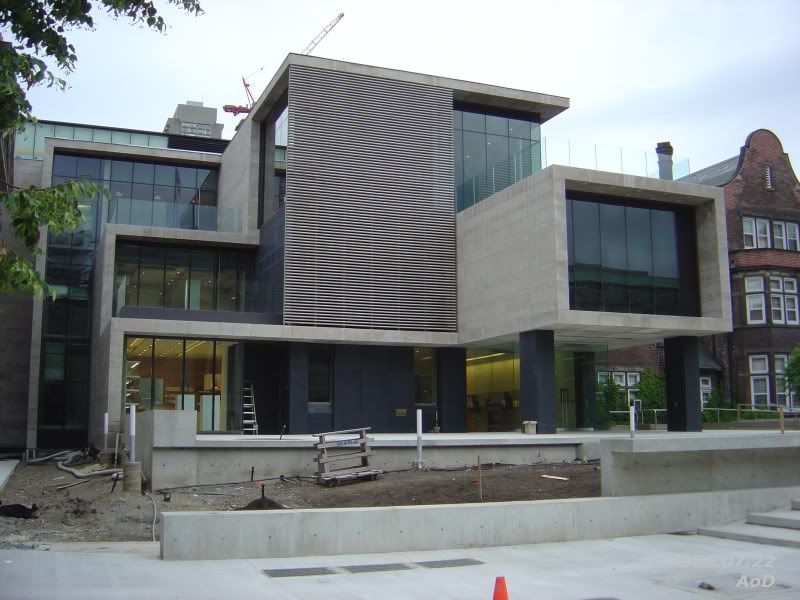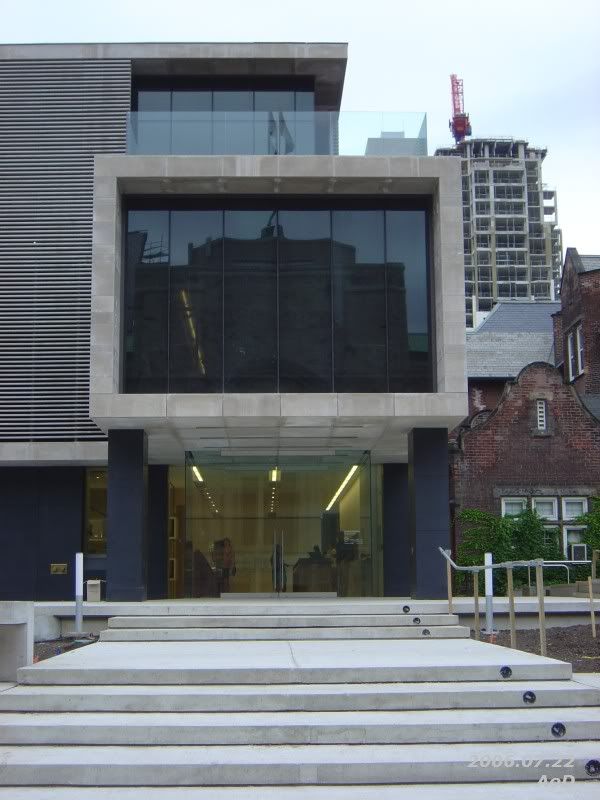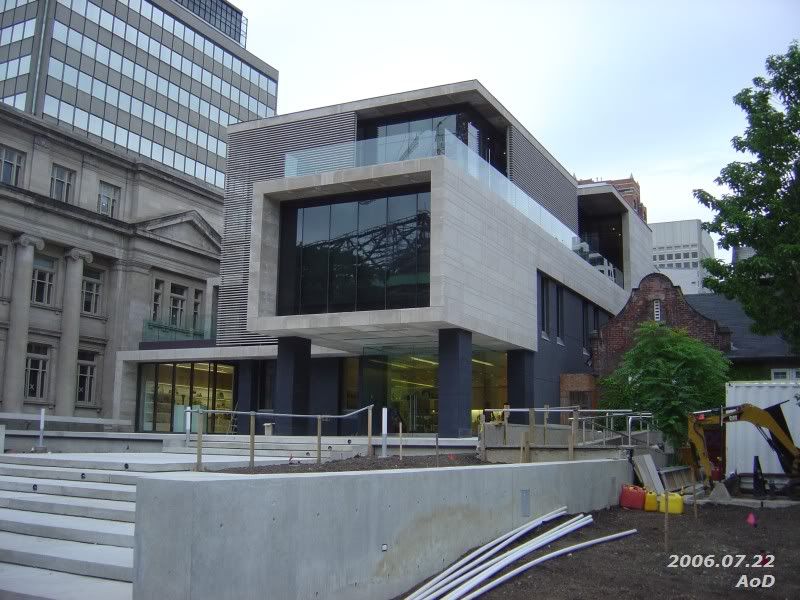A
AlvinofDiaspar
Guest
OT - but it's quite opportune re: Museum of Medicine - from U of T news:
Landmark sculpture a tribute to U of T's giants of biomedical science
U of T pioneers of biomedical sciences research honoured
Jun 28/06
by W.D. Lighthall
A magnificent bronze sculpture unveiled June 27 in the University of Toronto’s new Giants of Biomedical Science Hall commemorates the university’s long history of breakthrough research in the biomedical sciences.
Located in the lobby of the recently opened and state-of-the-art Terrence Donnelly Centre for Cellular and Biomolecular Research, the bronze sculpture depicts 10 leading researchers whose accomplishments at U of T have made vital contributions to advancing the prevention and treatment of disease.
The sculpture was created by Veronica de Nogales Leprevost and Edwin Timothy Dam, of Dam de Nogales Sculptors. The researchers and doctors represented in the sculpture (find the full list at the end of this story) include: Sir Frederick Banting, co-discoverer of insulin at U of T in 1922; Dr. Charles Best, who collaborated with Dr. Banting on the discovery of insulin; and Dr. Lap-Chee Tsui, who in 1989 discovered the gene for cystic fibrosis.
“Today we pay tribute to some of the University of Toronto’s giants of biomedical science – women and men who made their mark at the university,†said Professor Catharine Whiteside, dean of the Faculty of Medicine. “Today, a new frontier of research opens before us. Researchers in this building and elsewhere are exploring human health at the cellular and molecular levels, expanding our understanding of the mechanisms of disease and looking for new ways to prevent and treat it. These researchers truly stand on the shoulders of these giants,†Whiteside said.
The other inductees are: Wilfred Bigelow, developer of the first artificial cardiac pacemaker; George Connell, biochemical research advocate and former president of U of T; Maud Menten, founder of modern enzymology; Fraser Mustard, advocate for early childhood development; Vera Peters, developer of lumpectomy as an alternative to radical mastectomy; Robert Salter, innovator in orthopedic surgery; and Louis Siminovitch, founder of the department of medical genetics.
These giants of biomedical science now literally have a reach extending 10 stories high. Each has had a floor in the 10-storey Donnelly CCBR named after them. On each floor a museum-quality display board provides information about each individual, their careers and accomplishments in biomedical research and medicine.
Mairi Best, a professor of earth and planetary sciences at McGill University and granddaughter of Charles Best, said her grandfather’s scientific accomplishments, which extend well beyond his work in the discovery of insulin, were driven by his insatiable curiosity for biomedical research. “I’d like people in this building to look at these plaques and keep in mind a couple things that really drove my grandfather. He could have sat on his laurels after 1922 but he didn’t,†she said. “For him, research was the thrill of the chase, curiosity and the sharing of knowledge and understanding with others. At its best, this is the culture of science and it’s a generous culture and one I hope will live on in this building.â€
In the 1980s, Lap-Chee Tsui was engaged in genetics research at the Hospital for Sick Children and at U of T’s Department of Medical Genetics and Microbiology. After eight years of painstaking research, Tsui and his team identified a key gene in the development of cystic fibrosis, a breakthrough which greatly contributed to knowledge about the disease. For these accomplishments, Tsui is now honoured in sculpture and with a floor plaque in the DCCBR.
“I would like to thank U of T for giving me this tremendous honour,†Tsui said. “My work was very much team work and this (new) building supports collaboration and the interdisciplinary approach that’s so very important.â€
www.news.utoronto.ca/bin6...8-2400.asp
AoD
Landmark sculpture a tribute to U of T's giants of biomedical science
U of T pioneers of biomedical sciences research honoured
Jun 28/06
by W.D. Lighthall
A magnificent bronze sculpture unveiled June 27 in the University of Toronto’s new Giants of Biomedical Science Hall commemorates the university’s long history of breakthrough research in the biomedical sciences.
Located in the lobby of the recently opened and state-of-the-art Terrence Donnelly Centre for Cellular and Biomolecular Research, the bronze sculpture depicts 10 leading researchers whose accomplishments at U of T have made vital contributions to advancing the prevention and treatment of disease.
The sculpture was created by Veronica de Nogales Leprevost and Edwin Timothy Dam, of Dam de Nogales Sculptors. The researchers and doctors represented in the sculpture (find the full list at the end of this story) include: Sir Frederick Banting, co-discoverer of insulin at U of T in 1922; Dr. Charles Best, who collaborated with Dr. Banting on the discovery of insulin; and Dr. Lap-Chee Tsui, who in 1989 discovered the gene for cystic fibrosis.
“Today we pay tribute to some of the University of Toronto’s giants of biomedical science – women and men who made their mark at the university,†said Professor Catharine Whiteside, dean of the Faculty of Medicine. “Today, a new frontier of research opens before us. Researchers in this building and elsewhere are exploring human health at the cellular and molecular levels, expanding our understanding of the mechanisms of disease and looking for new ways to prevent and treat it. These researchers truly stand on the shoulders of these giants,†Whiteside said.
The other inductees are: Wilfred Bigelow, developer of the first artificial cardiac pacemaker; George Connell, biochemical research advocate and former president of U of T; Maud Menten, founder of modern enzymology; Fraser Mustard, advocate for early childhood development; Vera Peters, developer of lumpectomy as an alternative to radical mastectomy; Robert Salter, innovator in orthopedic surgery; and Louis Siminovitch, founder of the department of medical genetics.
These giants of biomedical science now literally have a reach extending 10 stories high. Each has had a floor in the 10-storey Donnelly CCBR named after them. On each floor a museum-quality display board provides information about each individual, their careers and accomplishments in biomedical research and medicine.
Mairi Best, a professor of earth and planetary sciences at McGill University and granddaughter of Charles Best, said her grandfather’s scientific accomplishments, which extend well beyond his work in the discovery of insulin, were driven by his insatiable curiosity for biomedical research. “I’d like people in this building to look at these plaques and keep in mind a couple things that really drove my grandfather. He could have sat on his laurels after 1922 but he didn’t,†she said. “For him, research was the thrill of the chase, curiosity and the sharing of knowledge and understanding with others. At its best, this is the culture of science and it’s a generous culture and one I hope will live on in this building.â€
In the 1980s, Lap-Chee Tsui was engaged in genetics research at the Hospital for Sick Children and at U of T’s Department of Medical Genetics and Microbiology. After eight years of painstaking research, Tsui and his team identified a key gene in the development of cystic fibrosis, a breakthrough which greatly contributed to knowledge about the disease. For these accomplishments, Tsui is now honoured in sculpture and with a floor plaque in the DCCBR.
“I would like to thank U of T for giving me this tremendous honour,†Tsui said. “My work was very much team work and this (new) building supports collaboration and the interdisciplinary approach that’s so very important.â€
www.news.utoronto.ca/bin6...8-2400.asp
AoD
